.gif)
Robur (truck)
Encyclopedia
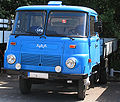
Volkseigener Betrieb
The Volkseigener Betrieb was the legal form of industrial enterprise in East Germany...
VEB Robur-Werke Zittau of East Germany (GDR). It mainly produced 3-ton trucks. The vehicles were produced in the town of Zittau
Zittau
Zittau is a city in the south east of the Free State of Saxony, Germany, close to the border tripoint of Germany, Poland, and the Czech Republic. , there are 28,638 people in the city. It is part of the Görlitz district....
in what now is South-East Saxony
Saxony
The Free State of Saxony is a landlocked state of Germany, contingent with Brandenburg, Saxony Anhalt, Thuringia, Bavaria, the Czech Republic and Poland. It is the tenth-largest German state in area, with of Germany's sixteen states....
. Until 1946, company produced under the marque Phänomen (English: Phenomenon), and until 1957 under the name VEB Phänomen Zittau.
History
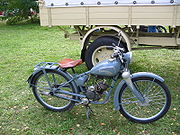
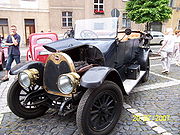
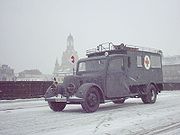
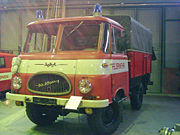

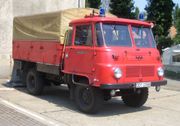
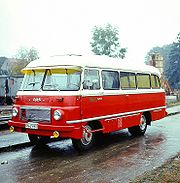

Pom-pon
A pom-pon is a fluffy, decorative ball or tuft. Pom-pons may come in many colors, sizes, and varieties and are made from a wide array of materials, including wool, cotton, paper, plastic, and occasionally feathers....
s that he had invented and would receive a patent for in 1894. On a trip to England he obtained an exclusive license to import and build Rover Safety Bicycles. He became shareholder and later owner of the Zittau machine factory "Müller & Preußger", refined the Rover bicycles and began to distribute them under the name "Phänomen-Rover" in 1894. In 1900 the company began to produce Phänomen motorcycles. At the start, the motorbikes were outfitted with Fafnir
Fafnir (automobile)
Fafnir was a German engine and vehicle manufacturer based in Aachen. They made a range of cars between 1908 and 1926.The company was founded in 1894 producing needles. With the growth of the bicycle industry, they started to make wheel spokes...
engines, but from 1903 onwards one-cylinder four-stroke engines of Phänomen design were used. This change of engine necessitated a strengthening of the bike frame and a change of wheels. Now 26-inch wheels with 2-inch tires were used. Permanent improvements led to the development of a two-cylinder engine.
In 1905 the company began the mass production of the three-wheeled Phänomobil. The two-cylinder engine used in motorbikes was used here as well. Similarities in construction with Berlin-made three-wheeler Cyklonette of Cyklon
Cyklon
Cyklon was a German make of car produced from 1902 to 1931. It was primarily noted for its unique three-wheeled design.- Three-wheelers :The three-wheeled Cyklon Cyklonette was made for 1902. It was a three-wheeler with a single wheel in the front to steer, and to provide propulsion from a 450 cc...
, led to arguments over patent infringement, especially as the engineers had worked for Hiller's company. A twin-fan-cooled four-cylinder four-stroke engine was used in the vehicles from 1910, production running until 1927. Between 1912 and 1927 the company, by now known as "Aktiengesellschaft
Aktiengesellschaft
Aktiengesellschaft is a German term that refers to a corporation that is limited by shares, i.e. owned by shareholders, and may be traded on a stock market. The term is used in Germany, Austria and Switzerland...
Phänomen-Werke Gustav Hiller", offered four-wheeled cars that could not establish themselves in the market. The coachwork was done by the "Karosseriewerk August Nowack AG" in Bautzen
Bautzen
Bautzen is a hill-top town in eastern Saxony, Germany, and administrative centre of the eponymous district. It is located on the Spree River. As of 2008, its population is 41,161...
.
By request of the Reichspost
Reichspost
- Imperial Reichspost :* The Imperial Reichspost was the name of the postal service of the Holy Roman Empire, founded by Franz von Taxis in 1495...
for a cheap, safe and capable vehicle, the company introduced its 4 RL truck that could carry loads between .75 and 1 tons. The basis for this model was the four-cylinder engine used in the Phänomobil. As demand for higher payloads increased, the company brought the Granit 25 (1.5 tons) and Granit 30 (2.5 tons) trucks into production in 1931 and 1936, respectively. With the increasing arms production in Nazi Germany
Nazi Germany
Nazi Germany , also known as the Third Reich , but officially called German Reich from 1933 to 1943 and Greater German Reich from 26 June 1943 onward, is the name commonly used to refer to the state of Germany from 1933 to 1945, when it was a totalitarian dictatorship ruled by...
the product portfolio was reduced to the Granit 1500 model (called Granit 27 after the war) with a payload of 1.5 tons.
All Phänomen trucks and tricycles had air-cooled engines, only the four-wheeled passenger cars were equipped with water-cooled engines. In 1930 the Phänomen-Werke Gustav Hiller A.G. Zittau took up production of light motorcycles, using Sachs engines. Until 1945 Phänomen produced 14 different models.
In consequence of a referendum of 30 April 1946 in Saxony, all property of those judged to be Nazis and war criminals was expropriated. In line with this, the Phänomen works became a Volkseigener Betrieb
Volkseigener Betrieb
The Volkseigener Betrieb was the legal form of industrial enterprise in East Germany...
. Aside from the production of desperately needed commodities, some 1000 vehicles of the Red Army
Red Army
The Workers' and Peasants' Red Army started out as the Soviet Union's revolutionary communist combat groups during the Russian Civil War of 1918-1922. It grew into the national army of the Soviet Union. By the 1930s the Red Army was among the largest armies in history.The "Red Army" name refers to...
were repaired. In 1949 the mass production of the pre-war models was resumed on a low scale. Only in January 1950 were the first 13 Granit 27 finished. In the next year the payload of the model was increased to 2 tons. 1952 the company presented the Phänomen-Granit 32 prototype that was equipped with an air-cooled diesel engine - in contrast to the carburetor
Carburetor
A carburetor , carburettor, or carburetter is a device that blends air and fuel for an internal combustion engine. It is sometimes shortened to carb in North America and the United Kingdom....
engines used until then. The mass production of the diesel engine began in 1954. In the meantime, the carburetor engine used in the Granit 27 model was improved and now had 60 HP
Horsepower
Horsepower is the name of several units of measurement of power. The most common definitions equal between 735.5 and 750 watts.Horsepower was originally defined to compare the output of steam engines with the power of draft horses in continuous operation. The unit was widely adopted to measure the...
. It was used in the Granit 30k model.
After changes to design, chassis
Chassis
A chassis consists of an internal framework that supports a man-made object. It is analogous to an animal's skeleton. An example of a chassis is the underpart of a motor vehicle, consisting of the frame with the wheels and machinery.- Vehicles :In the case of vehicles, the term chassis means the...
and some minor modifications to the Granit it became the Garant model that woould see 50,000 pieces built in several variations (bus, truck, ambulance) until 1961. Aside from the Garant K 30 model with a petrol engine the Garant 32 with a diesel engine was also available.
In the beginning of 1957 the company was renamed VEB Robur Werke Zittau, as the heirs of the company founder Hiller had no intention of allowing the new company to use the Phänomen brand. The name Robur stems from the Latin name of the pedunculate oak, Quercus robur. The logo design was inspired by a crankshaft. Several other factories were merged with the company, among others the auto body works in Bautzen and Zittau, the engine plant in Kamenz
Kamenz
Kamenz is a Lusatian town in eastern Saxony, Germany, with a population of 18,243, and is part of the Bautzen district. The town is located about northeast of Dresden and about northwest of Bautzen....
and the fire-extinguisher works in Görlitz
Görlitz
Görlitz is a town in Germany. It is the easternmost town in the country, located on the Lusatian Neisse River in the Bundesland of Saxony. It is opposite the Polish town of Zgorzelec, which was a part of Görlitz until 1945. Historically, Görlitz was in the region of Upper Lusatia...
. The very successful Garant model was replaced by the Robur LO 2500. It was first presented at the Leipzig Trade Fair
Leipzig Trade Fair
The Leipzig Trade Fair was a major fair for trade across Central Europe for nearly a millennium. After the Second World War, its location happened to lie within the borders of East Germany, whereupon it became one of the most important trade fairs of Comecon and was traditionally a meeting place...
in 1961 and was constructed according to international development trends of the time. This modern COE
Cab over
Cab-over, also known as COE , cab forward, or forward control, is a body style of truck or van that has a vertical front or "flat face", with the cab of the truck sitting above the front axle...
truck had the carburetor engine of its predecessor, with an increased output of 70 HP. It had a payload of 2.5 tons. The four-wheel driven variation with a 1.8 ton payload was called Robur LO 1800 A.
Further development resulted in 1968 in the LO 2501 and LO 1801 A models, distinguishable by a changed grille
Grille
A grille or grill is an opening of several slits side by side in a wall or metal sheet or other barrier, usually to let air or water enter and/or leave but keep larger objects including people and animals in or out.-Spelling:In the United States, "grille" is used to differentiate the automotive...
. Several further improvements were made over the years, before the 3-ton truck LO 3000 was introduced in 1974. It became the basis for a number of special models. The four-wheel variant also saw its payload increased and was sold under the designation LO 2002A. From the fall of 1982 a diesel engine was offered alongside the carburetor engine Type 4 KVD 12,5 SRL. Development of the LD/LO 3000 series in the 1980s aimed to extend the lifetime of the various components and reaching international level in terms of quality. These changes, that were in part also made to the AWD types LD/LO 2202 A, led to the diesel-driven models LD 3001 and LD 3002, recognizable by smaller wheels and increased tread
Tread
The tread of a tire or track refers to the rubber on its circumference that makes contact with the road. As tires are used, the tread is worn off, limiting its effectiveness in providing traction. A worn tire tread can often be retreaded. The word tread is often used incorrectly to refer to the...
. The carburetor-engined LO variants lost import.
Robur trucks were not only deployed in the COMECON
Comecon
The Council for Mutual Economic Assistance , 1949–1991, was an economic organisation under hegemony of Soviet Union comprising the countries of the Eastern Bloc along with a number of communist states elsewhere in the world...
area, but in several overseas countries. Especially in order to open up new markets the Robur-Safari program was created. Here trucks would be adapted to the climatic and geographic conditions of their future country of deployment.
The production of the newly developed O 611/O 611A and D 609 models was not approved by the government and development was restricted to existing models.
After German reunification
German reunification
German reunification was the process in 1990 in which the German Democratic Republic joined the Federal Republic of Germany , and when Berlin reunited into a single city, as provided by its then Grundgesetz constitution Article 23. The start of this process is commonly referred by Germans as die...
the company quickly folded. Deployment of Deutz
Deutz
There are multiple topics for Deutz* Deutz, Cologne, a former town, since 1888 a quarter of Cologne, Germany* Deutz AG, a diesel-engine manufacturer based in Cologne, Germany* Deutz-Fahr and Deutz-Allis, an agricultural equipment company....
diesel engines did nothing to save it and production was cancelled in 1991. In 1995 a new company called Robur-Fahrzeug-Engineering GmbH was founded and bought all know-how of the Robur-Werke Zittau. In 1999 another successor was founded with FBZ GmbH Zittau. The company builds and supplies components for vehicles.
Passenger cars 1907–1927
| Type | Built | No of cylinders | Displacement | Power | Maximum speed |
|---|---|---|---|---|---|
| Phänomobil 4/6 PS | 1907–1912 | V-2 V-twin A V-twin engine is a two-cylinder internal combustion engine where the cylinders are arranged in a V configuration.- Crankshaft configuration :Most V-twin engines have a single crankpin, which is shared by both connecting rods... |
887 cc | 6–9 HP (4.4–6.6 kW) | 50 km/h |
| 10/28 PS | 1912–1919 | I-4 | 2597 cc | 28 PS (20.5 kW) | 80 km/h |
| Phänomobil 6/12 PS | 1912–1920 | I-4 Straight-4 The inline-four engine or straight-four engine is an internal combustion engine with all four cylinders mounted in a straight line, or plane along the crankcase. The single bank of cylinders may be oriented in either a vertical or an inclined plane with all the pistons driving a common crankshaft.... |
1548 cc | 12 HP (8.8 kW) | 60 km/h |
| 10/30 PS | 1920–1924 | I-4 Straight-4 The inline-four engine or straight-four engine is an internal combustion engine with all four cylinders mounted in a straight line, or plane along the crankcase. The single bank of cylinders may be oriented in either a vertical or an inclined plane with all the pistons driving a common crankshaft.... |
2612 cc | 30 HP (22 kW) | 65 km/h |
| 16/45 PS | 1920–1924 | I-4 Straight-4 The inline-four engine or straight-four engine is an internal combustion engine with all four cylinders mounted in a straight line, or plane along the crankcase. The single bank of cylinders may be oriented in either a vertical or an inclined plane with all the pistons driving a common crankshaft.... |
4219 cc | 45 HP (33 kW) | 75 km/h |
| Phänomobil Typ V (6/12 PS) | 1920–1927 | I-4 Straight-4 The inline-four engine or straight-four engine is an internal combustion engine with all four cylinders mounted in a straight line, or plane along the crankcase. The single bank of cylinders may be oriented in either a vertical or an inclined plane with all the pistons driving a common crankshaft.... |
1548 cc | 12 HP (8.8 kW) | 55 km/h |
| Typ 412 (12/50 PS) | 1924–1927 | I-4 Straight-4 The inline-four engine or straight-four engine is an internal combustion engine with all four cylinders mounted in a straight line, or plane along the crankcase. The single bank of cylinders may be oriented in either a vertical or an inclined plane with all the pistons driving a common crankshaft.... |
3132 cc | 50 HP (37 kW) | 100 km/h |
Trucks 1927–1991
Most vehicles were equipped with a petrol engine. The type designation LO (Luftgekühlter Ottomotor, German for air-cooled petrol engine) led to the nickname Ello which became the popular designation for all Robur trucks, as it is impossible to differentiate between the diesel and petrol engines from the outside.The vehicles were modified for a number of different purposes, e.g. a mobile pharmacy
Pharmacy
Pharmacy is the health profession that links the health sciences with the chemical sciences and it is charged with ensuring the safe and effective use of pharmaceutical drugs...
, fire engines and dumpers. Generally speaking, the following models existed.
All-wheel drive vehicles
- LO 1800A/1801A (air-cooled petrol engine, the A is for "Allrad", the German term for all-wheel drive)
- LO 2002 (air-cooled petrol engine, 2 ton payload)
- LD 2002 (air-cooled diesel engine, 2 ton payload)
- LD 2202 (air-cooled diesel engine, 2.4 ton payload)
- Safari models, modified for export
- vehicles with closed body, multi-purpose
Rear-wheel drive vehicles
- Bus - B21 Type LD 3001 FR M2/B21
- Refrigerator truck
- Light panel van
- Pick up
- Multi-purpose Type LO 3002 Fr M5/MZ 11

